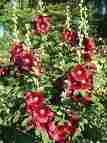Which Plants are Best for Your Septic Soakaway? | WTE
Septic Tank - Planting over or near the Soakaway
Table of Contents

Septic Tank soakaways, when correctly installed, do not smell, so there is no need to plant anything other than grass over them. However, many people, especially those with smaller gardens, want to make a 'proper' garden over them. There are a few rules as to what can be planted, but every soakaway is different. You can decide what will work best on your site, however, by following a few simple guidelines.
Why Plant over the septic tank soakaway at all?
Return to Table of Contents
Which Plants Are Best for My Septic Soakaway?
Return to Table of Contents
Herbaceous Perennials and Annuals
Return to Table of Contents
Trees, Shrubs, and Your Septic Tank Soakaway
Some smaller and less-aggressive species may be more suitable for planting over the soakaway. Some possibilities include fibrous rooted shrubs such as boxwood or holly, or small trees such as dogwoods. When planting shrubs in a soakaway field, place them between the drain runs. Normally, drainage trenches are 600mm. wide with 2 metres between trenches.
Finally, you must decide what is more important to you - the soakaway or the plants. One septic soakaway we know of was completely blocked by Weeping Willow roots within 3 years of its construction. The roots had also travelled up the drain and into the biodisc sewage treatment plant, destroying it and the entire system had to be totally replaced.
Reducing Tree Root Intrusion Into the Septic Soakaway
Choose less aggressive species. By selecting trees with less aggressive roots, (see the table), you can greatly reduce the likelihood of your trees damaging or blocking the soakaway.
Plant trees as far away as possible from the soakaway. In order to be completely certain that tree roots will not intrude into your septic tank soakaway, trees should be planted at least as far away as their estimated root spread at maturity. One way to estimate this is from the height of the fully grown tree. For example, an oak tree can be expected to reach around 20 metres in height when mature. so it would need to be planted at least 20 metres away from the edge of the septic tank soakaway area.
Prepare the soil for your trees before planting. Roots tend to grow along "paths of least resistance", so it is wise to dig up as wide an area as possible for your new tree before planting to provide a good rooting environment. Prepare the soil really well on the side of the plants that faces away from the drain field, digging in plenty of compost, manure, etc. as this is the direction in which you want the roots to grow. If you plant a tree in shallow topsoil over a compacted subsoil - a common problem in new housing developments which have paddled over the existing soil during the build and then landscaped using sandy topsoil - the first easy route in the soil that a tree root finds could be your septic tank soakaway trench. Good soil preparation can help stop roots from blocking your drain pipes because tree roots will be better able to take up enough water and nutrients from the soil without sekking them in the soakaway.
Choosing Trees For Planting Near Your Septic Tank Soakaway
| Not Recommended for Planting Near Soakaways | Better Choices for Planting Near Soakaways |
| Beeches Birches Elms Poplars Red Maple Silver Maple Willows Hydrangea | Fagus spp. Betula spp. Ulmus spp. Populus spp. Acer rubrum Acer saccharinum Salix spp. Hydrangea | Cherries Crabapples Dogwoods Hemlock Oaks Pines Sorrel tree | Prunus spp. Malus spp. Cornus spp Tsuga spp. Quercus Pinus spp. Oxydendrum |
Does the Septic Tank Effluent Affect the Soil?
Septic Tank effluent alters the soil conditions. It is important to understand your soil type before deciding on any landscape planting. Some plants prefer sandy, dry soil and some prefer wetter clay soils. Some plants like acidic soils and some prefer alkaline soils. Many household chemicals and washing powders are highly alkaline and can raise the pH of the effluent, making it more alkaline. The pH of the effluent will alter the pH of the soil, so have soil samples from the drain field tested periodically so that you can adjust the soil pH as necessary with products like Sequestrene, if you have plants that like acidic conditions, eg Azaleas. 
Septic Tank effluent contains a lot of salt (see also sodium binding) and it is essential to plant species that are tolerant to salt in the soakaway. Plants that are both salt and moisture tolerant include hollyhocks, bee balm (Himalayan Balsam), violets, arborvitae, dogwood, inkberry holly. Other plants that are tolerant of salt include yarrow, columbine, chrysanthemum, delphinium, daylily, peony, clematis, and rose, although these will not do so well on very wet septic tank soakaways. You will also find that you need much less fertiliser, if any at all, as the septic effluent contains many plant nutrients..
Return to Table of Contents
Soakaway Vegatable Gardens
- Do not plant root vegatables over the drain trenches.
- Low level green vegatables like cabbages could be contaminated by rain splashing soil onto the plant, so either cover the ground with straw or mulch or discard the lower leaves.
- Fruit bushes should be OK, but you might want to discard any low level fruit.
- Tie cucumbers or tomatoes onto a support so that the fruit is off the ground.
- Thoroughly wash any vegatables from the garden before eating it.
- Do not put raised beds over the field as the drains will then be too deep for aerobic soil conditions to treat the effluent.
- Do not put paths or greenhouses over the soakaway as this is against Section H2 of the drainage and septic tank Building Regulations.
